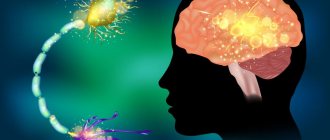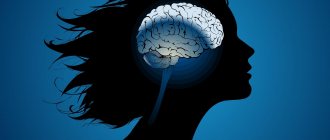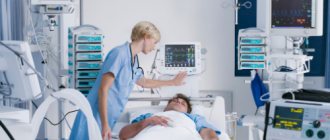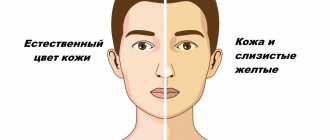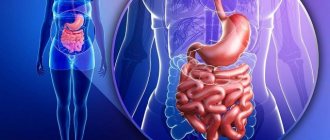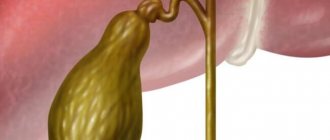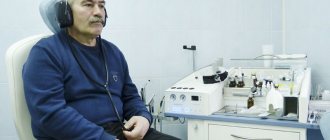The earliest manifestations of confusion and disorientation include a sharp decrease in concentration. During progression, there is a complete disruption of sensitivity to the outside world, memory lapses occur, logical thinking is modified, the patient does not understand what is happening, recognizable memory and full-fledged speech are impaired, and emotional distress occurs. As a result, depression, silence and inactivity of a person are recorded. The psychiatrist must distinguish between these aspects and provide a presumptive diagnosis when communicating with the patient.
General information
Confusion is a pathology in which a person’s ability to navigate in time or space is impaired. At the same time, attention may decrease, and sometimes there are lapses in short-term memory. Such manifestations are associated with impaired brain activity and can be a symptom of both mental and somatic diseases. Various conditions can provoke them: acute intoxication , dehydration, heat stroke , hypothermia, severe stress, etc.
In this state, a person can wander the streets, get confused in time, look lost and distracted. Pathological disorientation often develops in older people suffering from neurodegenerative diseases and brain lesions. If the process progresses, the patient may experience impaired perception and memory, recognition and speech. Emotional disorders, etc. are noted. Neuropsychological and clinical methods are used in the diagnostic process. Treatment is conservative.
The treatment methods and features of this condition will be discussed in more detail in this article.
Current of development
To correctly establish the primary diagnosis, it is necessary to note the causes of the anomaly. Fundamental experts identify the following factors:
- psychological disorders leading to a serious disorder in consciousness;
- stress, nervous overstrain;
- exceeding the norm of ppm alcohol in the blood;
- drug intoxication;
- medications: tranquilizers, antidepressants, sedatives;
- long-term exposure to increased background radiation;
- period of recovery from anesthesia;
- progressive depression;
- Alzheimer's disease;
- senile pseudosclerosis;
- vegetative-vascular dystonia;
- schizophrenia;
- hypoglycemia;
- senile dementia;
- lack of water resources in the body;
- insufficient kidney function;
- epileptic disease;
- malignant brain tumor;
- benign brain tumor;
- hyperthermia;
- infection with encephalitis tick.
Disorientation can be observed during a high-power impact and in a large emotional outburst. With this development, fainting often occurs. A one-time case is not a consequence of the occurrence of pathological processes. However, to be on the safe side, a consultation with a psychiatrist is necessary.
Pathogenesis
To successfully navigate in space, a person must maintain normal cognitive activity, recognize spatial landmarks, mentally imagine and remember space, and distinguish between left and right sides.
When the brain receives visual information, it processes it in the primary projection areas of the occipital cortex. Then it enters the posterior convexital sections, the lateral surface of the temporal lobe. This process allows you to recognize and determine the position of objects.
Short-term memory of space, thanks to which a person moves, is provided by the prefrontal cortex. Consequently, the basis for the pathogenesis of disorientation is the cognitive component, as well as the pathology of the activity of a number of brain structures.
Classification
There are several types of disorientation and confusion.
- Radiation is a consequence of exposure to high doses of radiation.
- Spatial – orientation in place is disturbed, disorientation in space occurs.
- Professional – is a consequence of professional activity.
- Social – a person with such a disorder takes a long time to get used to society and shows anxiety in unusual situations.
From a psychological point of view, the following forms of disorientation are distinguished:
- Autopsychic – a person lacks the perception of personal factors and social affiliation. He cannot reproduce his first name, last name, date of birth, etc. In this condition, the patient perceives the world around him completely differently and does not orient himself in it.
- Allopsychic – a violation of the perception of time and space. The patient may not understand where he is, incorrectly name the time of day, date, month, etc.
- Amnestic - both allopsychic and autopsychic orientation are disturbed at the same time. This disorder is caused by amnesia . In this state, the patient may not recognize himself in the mirror or in photographs. He cannot name his personal data, describe his habits, etc.
- Somatopsychic – the patient does not perceive his own body, mistaking its organs for someone else’s.
- Delusional - a person in this state forgets real events, and he has a false idea of what is happening.
In medicine, the following types of consciousness disorders are also distinguished:
- Stunned state of consciousness - occurs most often, manifests itself in acute disorders of the central nervous system, infectious diseases, and head injury. With such a degree of impairment of consciousness, irritability appears and the formation of associations becomes difficult. The person is indifferent, silent, indifferent, poorly oriented in the world around him. This state can last for several minutes or several hours.
- Delirious clouding of consciousness - the patient develops delusions, illusions and persistent hallucinations . Most often, this happens as a consequence of TBI or the influence of infections.
- Oneiric or dream consciousness - the patient has a correlation between emerging fantastic ideas and a reflection of the real world.
- Delirium – in this condition, a person partially loses memory: fragments of events “fall out” from him.
- Twilight clouding of consciousness - this state is characterized by deep disorientation in space with the preservation of habitual automated actions. After the patient develops a twilight disorder of consciousness, amnesia occurs. This condition appears suddenly. A twilight state of consciousness is usually a short period of disturbance of consciousness that replaces deep sleep. The following types of it are determined: delusional variant (the patient may show aggression, which seems pre-planned. After normalization of the state, actions are perceived as alien to the individual); hallucinatory variant (hallucinatory experiences predominate); oriented option (elementary orientation is preserved); drowsy state (appears after a sharp exit from the slow-wave sleep phase).
- Paroxysmal disorders of consciousness - with this pathology, disorders arise suddenly and stop abruptly. Such attacks are called paroxysms . Paroxysmal disorder manifests itself periodically.
- Depersonalization – this state is characterized by a feeling of alienation, one’s own “I”, one’s thoughts. A person seems to perceive himself from the outside.
There is also a condition called akinetic mutism . This is a condition in which a person completely loses the ability to move and speak and does not respond to painful stimuli.
What is disorientation?
It is classified as a mental disorder and can cause certain changes in the functioning of the central nervous system. It is divided into short-term and long-term, depending on a number of factors. The patient is unable to describe himself as a person; there is no temporal and spatial orientation. It should not be confused with childhood social disorientation, which is a temporary age-related process. The phenomenon is divided into two types: allopsychic, autopsychic. In the first case, there is an inability to determine location, as well as to separate time periods. In the second case, it is impossible to name the first name, last name, patronymic, date of birth, place of residence. For diagnosis, the right questions are asked and clarity is established. If it is confused, urgent consultation with a psychiatrist is necessary. To be admitted to a psychiatric hospital, the patient's voluntary consent to medical care is required. Impaired consciousness makes it impossible to objectively assess the situation; hospitalization is carried out according to the estimated condition at the time of treatment. Direct relatives and family members can help expedite legal issues.
Causes of confusion
The reasons why disorientation and confusion occur can be quite varied. Most often, these manifestations are caused by the following factors:
- Alcohol intoxication , a disorder of consciousness associated with taking large doses of alcohol, is easy to recognize. Such people show disorientation, anxiety, and lack of understanding of the situation in which they find themselves.
- Intoxication due to taking medications - with this condition, a person’s level of wakefulness decreases. Taking many drugs provokes pupillary disturbances and nystagmus .
- Encephalitis - confusion in this disease manifests itself acutely. However, such manifestations are nonspecific, so the disease can be diagnosed through tests and research.
- Vascular diseases of the brain - intracerebral hemorrhage, etc. can lead to confusion.
- Multi-infarct dementia - with this condition, periodic attacks of confusion occur.
- Alzheimer's disease is a chronic symptom, and acute confusion in such a disease often occurs with sudden changes in the patient's life.
- Metabolic disorders - confusion can occur in various diseases associated with metabolic disorders.
- Epilepsy is a confused state that can develop after a seizure or series of seizures.
- Hidden bleeding leads to the development of hypoxia , which is the cause of disorientation.
- Post-traumatic psychosis – after trauma, disturbances in the interpretation of what is happening around, anxiety, and anxiety are possible.
- Mental disorders.
- Traumatic brain injuries.
Causes
The following reasons for the occurrence of the phenomenon of confused consciousness are identified:
- traumatic (consequences of penetrating traumatic brain injury);
- in case of brain injury (organ tissues are highly sensitive);
- the occurrence of an aneurysm (an enlarged blood vessel affects neighboring tissues);
- mercury poisoning;
- increased dose of alcohol in the blood;
- drug intoxication;
- effects of neurotropic gas on the respiratory system;
- entry of organophosphorus compounds into the digestive system;
- poisoning with neurotoxic substances – puffer fish, mushrooms, carambola;
- hyperthermia resulting from infectious diseases;
- pain shock during a fracture, dislocation, significant blood loss;
- severe diseases - tuberculosis, encephalitis, diabetes mellitus, all types of hepatitis, acquired human immunodeficiency syndrome at the final stage of development;
- progression of the growth of a cancerous tumor at the last stage - decay (during the process intoxication occurs);
- coronary heart disease, all types of strokes, occurring both unnoticed and obvious;
- myocardial infarction, with pronounced pain and impaired blood flow;
- vegetative-vascular dystonia – dilation of blood vessels occurs in areas of the autonomic nervous system of the body;
- age-related diseases: senile dementia, Alzheimer's disease, marasmus of all types;
- bright emotional outburst;
- hypothermia;
- a period without sleep for a long time;
- oxygen starvation;
- 1st and 2nd degree stunning.
Symptoms of confusion
The main symptoms of confusion are disorientation in space and time.
- A person is often unable to remember events that just happened.
- Attention is impaired and confusion is noted.
- The body's reactions slow down.
- Inappropriate emotions are possible.
- When intoxicated, confusion often accompanies tremors , eye symptoms, and a decrease in temperature.
- With TBI drowsiness , lethargy , headaches , convulsions , and coordination problems are possible.
- When spatial disorientation occurs, a person loses the ability to imagine how objects are located relative to his body and does not recognize the objects that surround him.
Symptoms of schizophrenia
Schizophrenia, the causes of which are not fully understood, is a complex disorder. That is why its manifestations are so diverse. Psychiatrists identify the following groups of symptoms in men and women suffering from schizophrenia:
- positive (or productive), which include agitation, hallucinations, delusions, disordered thinking and obsessions;
- negative (apathy, weak-willedness, social isolation, lack of purposefulness, enthusiasm and proper emotional reactions);
- cognitive (memory and concentration problems, thinking disorders, inadequate perception, etc.).
A patient suffering from this disease often has problems in various areas of life (they cannot work or study normally). A person stops taking care of himself and becomes depressed, as a result of which he experiences some lack of attention from the opposite sex. In women, the clinical picture of schizophrenia may be accompanied by the presence of a symptom such as bulimia.
Tests and diagnostics
The examination is carried out by a psychiatrist or neurologist. The following diagnostic methods are used during the research:
- Patient interview . During the interview, the doctor determines the presence of symptoms, their characteristics and duration.
- Neurological examination . The specialist determines whether focal and cerebral symptoms are present.
- Neuropsychological examination.
- General and biochemical blood test . Allows you to establish or exclude acute intoxication and infection.
- MRI . It is carried out to determine organic changes in the brain and blood flow disorders.
- EEG . Characteristic signs of epilepsy .
Symptoms of the disease
Changes that help establish the diagnosis are pronounced dizziness, variable mood, disturbed sleep, problems with remembering facts, inability to identify a person, internal psychological anxiety without outside provocation.
Spatial symptoms stand out: a sharp change in mood - an apathetic state changes to an aggressive one.
Help in this situation can only be found in a specialized institution that works with psychologically unbalanced people.
A separate category is social disorientation, which cannot be classified as a mental disorder. Its specific features: unclearly pronounced age, long-term adaptation to society, anxiety in an unusual situation.
Vegetative-vascular dystonia provokes worsening symptoms - vomiting, active progressive dizziness, tinnitus, complete or partial hearing loss, headaches, and fluctuating blood pressure.
The diagnostic complex involves an initial consultation with a psychiatrist and a neurologist. The doctor performs manipulations with the patient, a full physical examination with questions to help establish the correct diagnosis. From the point of view of physical manipulations, there is blood sampling for biochemistry and general clinical analysis. A test is performed to detect drugs in the body. Mandatory coagulogram and magnetic resonance imaging of the brain. At the same time, the patient is sent for specialized tests to identify his psychological level.
First aid
If consciousness is impaired, it is necessary to provide adequate first aid and, if necessary, call an ambulance. It is important to consider that signs of disorientation may indicate the development of serious illnesses. Sometimes confusion is a sign of a developing stroke . If there is such suspicion, a doctor should be called immediately. If a person has difficulty breathing, they need to remove tight clothing and provide fresh air. It is better that before the ambulance arrives, the patient is in a lying or sitting position and does not change it.
Prevention
To prevent the development of diseases in which confusion and disorientation may develop, it is necessary to follow these rules:
- Eat right, trying to introduce the maximum amount of healthy and vitamin-rich foods into your diet.
- Lead an active life and play sports.
- Get rid of bad habits.
- Regularly train your memory and brain by solving crosswords, puzzles, etc.
- Get proper rest, sleep at least 7 hours a day.
- Conduct preventive blood tests, monitoring sugar levels, cholesterol and other indicators.
- Avoid head injuries.
- Timely and correct treatment of diseases of the nervous system, blood vessels, heart, etc.
Impaired consciousness
According to K. Jaspers (1923), the following signs are common to all types of disturbances of consciousness:
- detachment, disorder of direct reflection of real objects and phenomena in the form of difficulty or shutdown of sensory cognition, its fragmentation or distortion associated with deceptions of perception;
- violation of rational cognition, that is, understanding of connections and relationships between objects and phenomena due to impoverishment, shutdown or disorganization of thinking, impaired judgment;
- disorientation in place, time, surrounding persons, and sometimes in one’s own personality. Orientation may be completely absent or false;
- difficulty remembering impressions of ongoing events and subjective experiences, which manifests itself upon exiting the state of impaired consciousness as congrade amnesia. Memories may be incomplete, inconsistent, unclear, alienated, like dreams. Some impressions, on the contrary, come easily to memory and are particularly vivid - the Moly phenomenon. There is also delayed or retarded amnesia, which occurs several minutes or even hours after the end of confusion.
| | A clinical psychologist will correctly diagnose and apply the necessary psychological measures to treat disorders of consciousness |
The diagnosis of clouded consciousness can be established if all four of the mentioned signs are present. But this does not mean that you need to wait for the cessation of acute psychosis and confirmation of the fact of amnesia in order to make sure that consciousness is impaired. It should also be borne in mind that shallow degrees of stupefaction may not be accompanied by obvious disturbances in orientation and the ability to make concrete judgments, even if later all the impressions of this period were lost.
A retrospective assessment of the fact of confusion sometimes has to be given by amnesia for the period of acute mental consciousness, as well as by the content of the surviving memories, which are often very typical for one or another form of confusion. Meanwhile, recognition of the type of clouding of consciousness is not always possible due to its mixed, transitional or very dynamic pictures. In such cases, confusion is stated without indicating its form. A distinction is made between non-productive and productive disorders of consciousness.
Non-productive disorders are characterized by a decrease in the activity of consciousness and the absence of productive psychopathological symptoms (delusions, deceptions of perception). A distinction is made between stunned consciousness, stupor and coma.
Stun. It is characterized by a significant increase in the threshold of perception for external and internal impressions, a slowdown and impoverishment of mental activity towards its complete cessation. Stunning is defined in this regard as a state in which the external with difficulty becomes internal, and the internal becomes external.
In a state of stunning, only intense stimuli cause a response and can attract the attention of patients. Questions are not perceived immediately, incompletely, the meaning of complex questions is not understood. The answers are monosyllabic, imprecise, and usually follow a long pause. Orientation in place, time, and events is incomplete, inaccurate, or completely disrupted. Increased drowsiness, spontaneity, akinesia, and indifference are noted. Affective reactions are extremely sluggish. The background mood can be euphoric. Facial expressions are poor, there is no gesture, the voice is quiet, without modulation. There is no understanding of the painfulness of the condition. Perseverations are observed. Memories of impressions during this period, and sometimes even the fact of stunning, are not preserved. There are no productive psychopathological symptoms, confusion, or fears observed.
Numbing is a mild degree of stunning. Patients give the impression of slightly intoxicated, distracted, uncollected people. They are stupid, do not immediately grasp the meaning of speech addressed to them, are somewhat late in perceiving what is happening, respond and act at random. Patients may be euphoric and fussy. Characteristic are fluctuations in clarity of consciousness and short episodes of inclusion in the situation. In a state of nullification, patients can assess their condition optimistically even with serious injuries. For example, after an injury, a patient makes no complaints, refuses medical care, and tries to help other victims while his own life is in danger. In this regard, patients are not hospitalized, discharged from the hospital ahead of time, or the patients themselves leave the department.
Somnolence is a form of shallow, but less dangerous than numbing, deafening of consciousness. Characterized by increased drowsiness. Left to himself, the patient immediately falls into a deep sleep. For a short time, through vigorous stimulation, he can be awakened, contact can be made, after which he falls asleep again. Somnolence can often be observed after convulsive seizures upon recovery from an epileptic coma. After a seizure, patients seem to sleep deeply for some time and only then come to their senses. It is possible to awaken them, although not without difficulty, but this should not be done - awakening may be incomplete and result in motor agitation with aggression.
Stunning resembles the symptoms of a psychoorganic syndrome (torpidity, spontaneity, weakness of judgment, memory), but is not one. It is observed upon recovery from a coma, but, in turn, can develop into stupor and coma.
Sopor. Only elementary manifestations of mental activity are preserved. In response to a loud call, the patient may, for example, turn his head, open his eyes briefly, or respond to an injection with a grimace of pain, a groan, or jerking his hand away. Various neurological disorders are detected: decreased muscle tone, weakened tendon, periosteal, skin reflexes, etc. Pain sensitivity, pupillary, corneal and conjunctival reflexes are not impaired.
Coma. Complete depression of mental activity. Muscle atony, areflexia, bulbar disorders, mydriasis with lack of pupillary response to light, pathological reflexes, pelvic disorders, etc. are detected. States of “brain death” with artificial maintenance of the functions of internal organs in resuscitation are called superior or beyond coma. Identical to apallic Kretschmer syndrome.
Stunning develops as a result of brain hypoxia, edema and swelling of brain tissue, damage to neurons by toxic products, and the development of acidosis in various pathological conditions (skull trauma, intoxication, vascular disorders, tumors, somatic diseases, etc.). Productive disorders of consciousness include delirium, oneiroid, twilight stupefaction, and amentia.
Delirium. It is characterized primarily by various disturbances of perception: illusions, hallucinations, disturbances of sensory synthesis. Visual illusions (pareidolia) and hallucinations (scene-like, zoological, demonomaniacal, palingnostic, cinematic, polyoptic, macro- and micro-optical, visions of threads, wires, webs, etc.) predominate. Tactile illusions of perception are often observed (the imaginary presence of parasites, reptiles, insects on the skin, under it; sensations of animal bites, blows, injections, cuts, spilling liquid). Some types of tactile hallucinations may indicate the nature of delirium.
In cocaine delirium, for example, these may be imaginary sensations of crystals. Delirium in tetraethyl lead poisoning is characterized by hallucinations localized in the oral cavity - an imaginary sensation of hair or threads. With infectious delirium, visceral hallucinations are possible. Typical delirium is characterized by:
- impairment of remembering what is happening, sometimes - confabulations. Thinking is fragmented, unstable figurative delusional ideas are expressed, and false recognitions are observed. Memories of the period of impaired consciousness are incomplete and incoherent;
- false and constantly changing orientation in place, time, surrounding persons, situations. Self-orientation is mostly preserved. Patients oppose themselves to visions, treat them as external to themselves, and do not identify themselves with them;
- affective lability. There is a rapid change in manifestations of fear, horror, surprise, curiosity, and indignation, reflecting the content of perceptual deceptions. Negative emotional reactions predominate. The latter can be colored by a peculiar humorous attitude towards perceived visions, as happens with alcoholic delirium (“gallows humor”);
- motor agitation, increased talkativeness. Patients are mobile, fussy, constantly feverishly busy with something, hiding, running away, attacking, defending themselves, etc. Sometimes there is an increased responsiveness to speech (for example, the patient can immediately answer questions, also addressed to strangers);
- fluctuations in the intensity of delirious phenomena with their intensification in the evening and at night and weakening during the day. Short-term clarity of consciousness can be observed during a conversation with patients.
There are three stages in the development of delirium. In the first, there is a slight increase in mood, acceleration of associations, influxes of vivid figurative memories, fussiness, hyperesthesia, sleep disturbances, anxious dreams, instability of attention, short-term episodes of disorientation in time, environment, situation, and affective lability. In the second stage, pareidolia occurs, anxiety increases, anxiety and fearfulness intensify, and dreams take on the character of nightmares. In the morning, sleep improves somewhat.
At the height of delirium, in its third stage, hallucinations, agitation, and disorientation are observed. Recovery from delirium is often critical, after prolonged sleep, followed by asthenia. The above-mentioned signs characterize the clinical picture of the typical, most common delirium. Other options are possible (A.G. Goffman). Abortive delirium - its duration does not exceed several hours, hallucinations are observed without disorientation. Hypnagogic delirium - hallucinations occur when falling asleep, but are not observed in reality.
Delirium without delirium - disorientation and fussy agitation are not accompanied by perceptual deceptions and delirium. Systematized delirium - scene-like visual hallucinations are observed, which, unlike oneiroid, lack megalomaniac content and scale. The depth of stupefaction may be insignificant, with partial orientation in place and time preserved.
In severe delirium, the phenomena of stunned consciousness with subsequent total amnesia and neurological, somatic and autonomic disorders predominate. Variants of severe delirium are, in particular, murmuring (mumbling) and professional types. The first is characterized by hyperkinetic, bed-bound excitation, inarticulate muttering and grasping movements - a symptom of carphology (nearby objects are grasped; in more severe cases, grasping movements are performed in the air). In occupational delirium, motor arousal is expressed by automated professional actions. There is no reaction to the environment and contact with patients in severe delirium.
Delirious stupefaction is observed in intoxication, infectious, somatogenic, traumatic psychoses, and organic diseases of the brain. Oneiroid. Dreamlike, fantastically delusional stupefaction. Characterized by the following features:
- an abundance of polymorphic psychopathological symptoms. An involuntary flow of vivid ideas (dreams, figurative mentism), scene-like hallucinations and pseudohallucinations, fantastic delusions, various sensory synthesis disorders, affective disorders, catatonic disorders, phenomena of depersonalization and derealization are observed;
- coherence, consistency of psychopathological experiences, their subordination to a single plot, one theme;
- romantic-fantastic content of painful experiences. Upon leaving oneiroid, patients talk about exciting travels, flights in the Universe, visits to other planets, ancient civilizations, the afterlife, new forms of life, etc. This can captivate patients to such an extent that, returning to real life, they regret about this and for some time they feel the desire to again plunge into rapturous dreams;
- violation of orientation in one’s own personality. Patients do not feel like witnesses to imaginary events, but rather their direct and active participants; they feel like they have been reincarnated into other beings, have died, and have changed their human quality. With delirium, according to a well-known comparison, the patient can be likened to a spectator in the stalls watching what is happening on stage. With oneiroid, the patient is no longer a spectator, he himself becomes an actor, a character, since during psychosis various disturbances of self-awareness arise, affecting the auto-, allo-, and somatopsychic spheres. One’s own body may be perceived as having disappeared, transformed into an uncertain state (cloud, beam, plasma, etc.). The soul “separates” and exists independently of the body, etc. The perception of time is disrupted: centuries, eras flash before the mind’s eye, time can go in any direction, freezes or flows intermittently. Orientation in the environment suffers. It can be partial, incomplete (oriented oneiroid), illusory-fantastic (the environment is perceived in accordance with the content of dreams), double (correct and false at the same time). At the height of oneiroid, there is complete detachment from the environment, the projection of fantastic pictures into the outside world disappears (Tiganov, 1982);
- the lack of connection between the content of painful experiences and the characteristics of external behavior, characterized by the phenomena of catatonic stupor or agitation. Contact with patients is severely limited or absent. By the way a patient behaves in oneiroid, it is impossible to determine what the content of his inner life is at this time. Only a few details of behavior allow one to guess about this: an enchanted gaze directed into space, individual words and phrases, symbolic actions, a mysterious smile, an expression of admiration;
- memories of subjective phenomena during oneiric stupefaction can be relatively complete and coherent. Impressions of what is happening in the surrounding reality are much worse reproduced or completely forgotten. There are depressive and expansive variants of oneiric clouding of consciousness.
In the first of them, the content of dream dreams is consonant with the prevailing depressive affect (scenes of hell, world cataclysms, etc.), in the second - with an elevated mood (exciting space travel, pictures of paradise, etc.).
In the development of oneiroid, observed in the clinical structure of attacks of recurrent schizophrenia, several stages are distinguished (Papadopoulos, 1967).
At the stage of clinical precursors of oneiroid, the dynamics of mental disorders are as follows.
The initial stage of the development of an attack is expressed by general somatic and affective disorders. Malaise, headaches, paresthesia, fainting, vomiting, low-grade fever and other general phenomena are observed. Affective disorders include mild depression, hypomania, alternating hypomania and depression. With depression, there is mild melancholy with irritability, capriciousness, touchiness, asthenia, drowsiness, overvalued education, sensitive ideas of relationships, hypochondriacal disorders. When mood increases, attention is drawn to excessive activity with hypersociality, “excellent” health and other disorders. A hypomanic state can have the character of a productive mania, but as agitation increases, the patients’ activities turn into a chain of unfinished undertakings.
At the stage of delusional affect, pronounced affects of fear, anxiety, increased confusion, various affectively saturated delusional ideas, and delusional behavior are observed. The phenomena of depersonalization are added (a feeling of alteration of the Self, alienation of one’s own mental acts). Episodes of delusional orientation in the environment occur.
At the stage of affective-delusional derealization and depersonalization, against the background of depression with lethargy, excited mania or labile affect, delusional ideas of staging, special meaning, intermetamorphosis, positive and negative doubles develop. A double orientation in the situation is characteristic: along with delusional disorientation, a generally correct understanding of the environment is preserved.
At the stage of fantastic affective-delusional derealization and depersonalization, fantastic delusional ideas appear (antagonistic delusions, delusions of grandeur, high origin, Cotard's delusions). Catatonic disorders are added. A double orientation in the situation, alternating at times with delusions, remains.
Subsequent disorders relate to oneiroid proper. There are three stages in the process of its development.
The first is the stage of illusory-fantastic derealization and depersonalization. It is characterized by an illusory-fantastic perception of reality: the surroundings are perceived as part of a fairy tale plot, an episode of a historical event, a scene of the other world, etc. A delirium of metamorphosis arises, a feeling of one’s own reincarnation into the characters of fairy tales, myths, and legends. Symbolism predominates in thinking: instead of causal connections and real relationships, symbolic connections and magical relationships are established. Among perceptual disorders, hyperesthesia, cinematic hallucinations, negative hallucinations, and pseudohallucinations predominate. Catatonic disorders are expressed. The orientation is delusional.
The second is the true oneiroid stage. The consciousness of patients is filled with dreams, they are immersed in a world of fantastic experiences. There is complete detachment from the environment. Colorful fantastic and romantic events unfold before the “inner eye” (magical initiations, apocalyptic scenes, etc.). Severe disorders of self-awareness (“fragmentation”, “dissolution”, monstrous metamorphoses of the Self) are characteristic. Catatonic disorders are most pronounced.
The third is the fragmentary oneiroid stage. It is characterized by the disintegration of a single storyline of oneiric experiences, their fragmentation, confusion within the dream-like fantastic events themselves. This stage resembles amental stupefaction and is usually completely amnesic.
Oneiric clouding of consciousness is observed in the structure of attacks of periodic and fur-like schizophrenia, with epileptic psychoses (in the form of paroxysms, without the dynamics described above), exogenous-organic and intoxication psychoses. Exogenous-organic and intoxication oneiric states are mostly short-lived, fragmentary, and rarely reach the level of dream-like oneiroid. The content of the experiences is banal, ordinary, and simplified; patients are more accessible to contact and do not exhibit significant catatonic disorders. Oneiric episodes often serve as a prelude to delirious stupefaction, so that it is not always easy to decide what the relationship is between one and the other component of confusion in the structure of psychosis.
Twilight stupefaction . Characterized by the following features:
- sudden onset and end of a painful condition;
- a sharp narrowing of the circle of actual ideas, thoughts and motives, a significant limitation of access to external impressions (probably the origin of the term itself is connected with this: patients perceive only a small part of the environment, just as with the onset of darkness only a little that is nearby is seen);
- frantic agitation of patients, in which extremely dangerous acts and senseless destruction are committed. Outwardly correct and formally ordered behavior, as if pre-planned, can also be observed;
- deep disorientation followed by complete amnesia. In a number of cases, elementary orientation in the environment, correct recognition of individuals, elements of self-awareness - an oriented twilight stupefaction - are preserved. There are episodes of twilight stupefaction confined to sleep. Thus, a patient with polymorphic seizures “suddenly” wakes up from time to time and does something for 5–10 minutes. For example, “looking for cockroaches in the kitchen.” In such states, she understands where she is, recognizes loved ones who are trying to find out what is happening to her, and answers questions. Then clarity of consciousness is just as suddenly restored, she understands that she was inadequate and remembers what she did.
The following types of twilight stupefaction are distinguished. Delusional variant - delusional ideas predominate, delusional behavior occurs. Amnesia here is incomplete - when questioned, patients report individual details about the delusional experiences that arose during the period of disturbance of consciousness. The hallucinatory variant is characterized by the dominance of frightening illusions, auditory and visual hallucinations, a state of hallucinatory excitement, and sometimes partial or delayed amnesia. In childhood, some types of night terrors can occur in this type.
Dysphoric variant - affective disturbances prevail in the form of anger, rage, fear with relatively mild clouding of consciousness. Dromomanic tendencies may also be detected. Outpatient automatism is paroxysms of a disorder of consciousness with externally ordered behavior such as aimless and fairly prolonged wandering (automatic walking) in the absence of delusions, hallucinations, or affective disorders. Sometimes provoked by a state of alcoholic intoxication. Seizures of ambulatory automatism can be confined to the period of sleep - somnambulism (sleepwalking).
Close to somnambulism is somnambulism - speech automatisms in a dream. In most cases, sleepwalking and sleeptalking are of a neurotic nature and are associated with dissociated sleep disorders. Unlike neurotic epileptic sleepwalking (meaning seizures themselves; neurotic forms of somnambulism can also be observed in patients with epilepsy) are characterized by a certain (like seizures) autochthonous rhythm of occurrence, develop on average much less frequently and usually without connection with the impressions of the past day. It is impossible to awaken an epileptic somnambulist: persistent attempts to do this can contribute to the development of a convulsive attack.
Paroxysms of sleepwalking are observed at a strictly defined time of the night and are reproduced in a stereotypical form. By the way, it should be noted that the practice of folk healers has long used observations about the difference between epileptic sleepwalking and neurotic sleepwalking: a sleepwalker would have a wet rag placed in front of the door or by the bed at night. A neurotic person usually wakes up when he steps on it, while an epileptic somnambulist does not. The next morning, patients feel exhausted, as after a regular seizure, and, as a rule, they do not remember the fact of sleepwalking. Probably similar to neurotic sleepwalking and sleep-talking are expressive acts in sleep. Usually emotions during dreams do not have external expression. But it often happens that patients laugh or sob in their sleep, waking up crying, with tears.
There are psychogenically caused twilight states, characterized by exclusion from the real situation and transfer to a hallucinatory, replacing a traumatic situation for patients. The environment is perceived incompletely, in accordance with painful experiences. The behavior of patients is bright, expressive, maybe even demonstrative. Partial amnesia is possible, covering mostly external events. There may be psychogenic episodes of ambulatory automatism, in particular somnambulism (an example from fiction is Lady Macbeth).
Hysterical twilight stupefaction is observed in reactive psychoses, as well as low-progressive schizophrenia with hysterical dissociative manifestations. A peculiar version of psychogenic twilight stupefaction - amok - was described among the aborigines of the Malay Archipelago. It manifests itself in sudden states of excitement with aggression and homocidal actions. In shamanism, during rituals (the shaman’s “communication” with spirits), the shaman, accompanied by singing and beating the drum, also falls into a hysterical twilight state with frenzy, ecstasy, sometimes ending in seizures.
Twilight disturbances of consciousness occur with epilepsy, brain tumors, pathological intoxication, in the acute period of traumatic brain injury, with vascular, intoxication psychoses.
Prolonged absence. A condition that superficially resembles stunning. Adynamia, apathy, immobility, difficulty perceiving and comprehending impressions, and perseveration are observed. The performance of habitual actions is not impaired, and this makes this condition similar to ambulatory automatism. Wrong things may happen. Prolonged absence begins and ends suddenly, its duration reaches several days. Brief episodes of clarity of consciousness are observed. The EEG reveals changes typical of absence seizures (peak-wave complexes with a frequency of three discharges per second). Apparently, a more adequate name would be “absence status.” In the status of complex absence seizures, various disturbances occur: catatonic episodes reminiscent of psychomotor seizures, twilight states, stupor - all this makes clinical diagnosis without an EEG study very problematic.
Amentia. Characterized by the following features:
- confusion with an affect of bewilderment and symptoms of hypermetamorphosis. There is also a rapid and chaotic change in the external manifestations of various emotions;
- incoherent thinking, incoherent speech, increased talkativeness;
- motor (hyperkinetic) excitation, usually limited to the bed, the breakdown of complex motor formulas. Choreiform hyperkinesis, catatonic disorders, senseless and uncoordinated throwing are observed - yactation, a symptom of carpology;
- deep disorientation in one’s own personality and the environment, followed by total congrade amnesia;
- scattered hallucinations, incoherent delusions, manic and depressive affects, delirious, oneiric episodes preceding the onset of amental confusion itself;
- asthenic phenomena upon recovery from a psychotic state;
- tends to be prolonged - the duration of amentia can be weeks or even several months. Amentia-like episodes observed during acute psychotic onsets of schizophrenia are usually shorter (hours, days).
A distinction is made between classic (confused), catatonic (mostly stuporous), manic, depressive and paranoid variants of amentive clouding of consciousness (Kraepelin, 1927; Meynert, 1980; Korsakov, 1892; Serbsky, 1892; Molokhov, 1961, etc.). It is noted that the classic version of amentia occurs mostly in toxic infectious diseases and the previously identified hypertoxic form of schizophrenia. Amentia has been described in infectious, somatogenic, intoxication, vascular diseases, organic lesions of the central nervous system, reactive psychoses, and schizophrenia. Not all authors identify it as an independent syndrome. Adjacent to amentia is a state of asthenic confusion identified by some authors, the development of which is based on an extreme degree of neuropsychic exhaustion.
Analysis of the clinical structure and dynamics of various forms of disorders of consciousness suggests the existence of important differences between them, indicating the depth of damage to the integrative mechanisms of mental activity. Thus, one can see that congrade amnesia is consistently worsened along the following chain of disturbances of consciousness: oneiroid, delirium, twilight stupefaction, amentia, stupor.
In the same order, impoverishment occurs, the impoverishment of subjective experiences, the aggravation of behavioral disorders, and the increasing vitalization of disorders (if we compare the typical forms of the mentioned forms of confusion).
This scale of disorders of consciousness also shows what combinations and transitions from one form to another are possible and what the clinical assessment of the corresponding tendencies should be. Thus, the transition of oneiroid to delirium or amentia indicates a worsening of the condition. The twilight gloom that occurs after stunning indicates dynamics in the opposite direction. The appearance of professional and exaggerated delirium marks a tendency to transition to a state of twilight stupor, and severe delirium to stunned consciousness. The end point of all forms of stupefaction is stunned consciousness, and then stupor and coma. Back to contents
Diet
Diet for the nervous system
- Efficacy: therapeutic effect after 2 months
- Timing: constantly
- Cost of food: 1700-1800 rubles per week
People prone to confusion should follow a healthy diet and avoid vitamin and mineral deficiencies. Nutrition should be complete. It is important to adhere to the recommendations given by the doctor, taking into account the characteristics of the disease.
It is recommended to include the following products in your diet:
- Vegetables, fruits, greens.
- Seafood, seaweed.
- Lean meat.
- Cereals.
- Nuts, seeds.
- Honey.
It is recommended to completely abstain from drinking alcohol, and also to minimize smoked foods, pickles, preserves and other harmful foods.
Consequences and complications
Disorientation and confusion are symptoms that can greatly limit people's social and physical activities. If adequate treatment is not provided, the condition may gradually worsen. Confusion may increase, making it difficult for a person to make decisions independently and carry out usual actions.
Frequent complications are anxiety and depressive disorders , behavioral abnormalities, manifestations of aggression , etc.

